One gorgeous, tender perennial that is unmistakable for any other is the calla lily. These plants produce beautiful “flowers” (technically spathes) with a simple, elegant shape that adds a touch of sophistication to any arrangement.

In this guide, you will learn how to plant and grow calla lilies in your own perennial garden. Use the advanced jump below to jump to the section you need, or read the full guide.
Jump to:
- What Are Calla Lilies?
- Calla Lily Basics
- Where Do Calla Lilies Grow?
- Are Calla Lilies Annuals or Perennials?
- Why Grow Calla Lilies?
- When Do Calla Lilies Bloom?
- How Long Do Calla Lilies Bloom?
- When to Plant Calla Lilies
- Ideal Growing Conditions for Calla Lilies
- How to Plant Calla Lilies
- How to Propagate Calla Lilies
- How to Care for Calla Lilies
- Recommended Planting Combinations for Calla Lily
- Calla Lily Landscaping Ideas
- Recommended Calla Lily Varieties
- Frequently Asked Questions About Growing Calla Lilies
- Where to Buy Calla Lilies
What Are Calla Lilies?
Despite their name, calla lilies are not true lilies. We define true lilies as plants that belong to the genus Lilium. See our True Lilies Full Growing Guide.
The name “calla lily” is actually used to refer to plants in two different genera:
• Zantedeschia: This genus consists of eight different species of perennials. Not all of the plants in this genus are called calla lilies, however. Usually, the name is just applied to Z. elliottiana and Z. rehmannii.
• Calla: There is just one species in this genus, Calla palustris. These types of calla lilies are also called bog arum, wild calla, marsh calla, water arum, and squaw claw plants.
Both of these genera are part of the Araceae family (the arum family). It is useful to note that a number of species that are currently classified as part of Zantedeschia used to be classified as members of Calla.
The plants we call calla lilies produce what looks like flowers. Each appears to be a single large petal that is curled into a kind of trumpet shape. In truth, this “flower” is a type of modified leaf that is referred to as a “spathe.”
The most iconic color for a calla lily spathe is white, but you can also find calla lilies that are yellow, orange, peach, red, purple, pink, or even more than one color.
Calla lilies are not to be confused with the similarly-named canna lilies, which are Canna x generalis.
Most people who are interested in growing calla lilies are specifically looking to plant Zantedeschia. For that reason, plants in that genus will be our main focus in this calla lily grow guide.
Calla Lily Basics
| Zones: | 8-10 |
| Blooming season: | Summer |
| Expected height: | 2-3 feet |
| Soil: | Rich, moist, well-draining soil |
| Sun: | Full sun to partial shade |
Where Do Calla Lilies Grow?
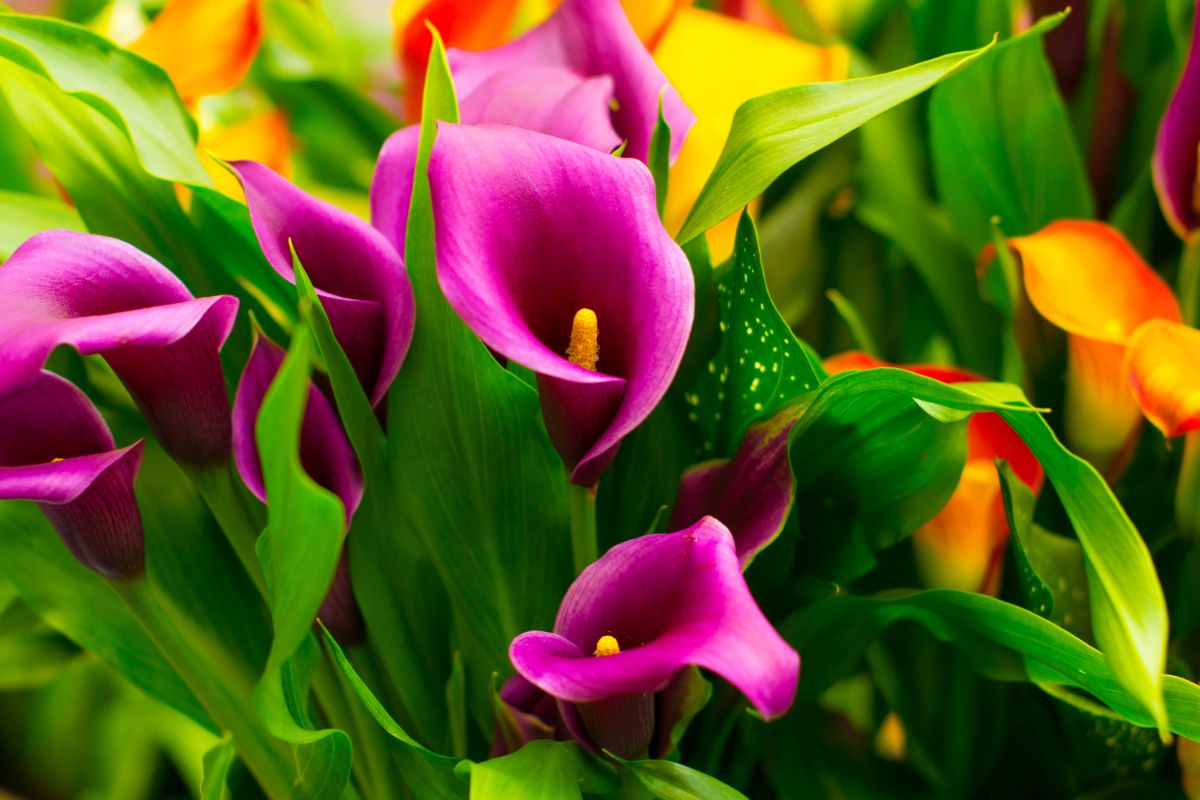
Calla palustris is native to northern Asia, North America, and northern Europe, favoring cool climates. By contrast, plants that belong to the Zantedeschia genus are native to southern Africa and flourish in warm climates.
Calla lilies are cultivated around the world. They may be sold as perennials or as annuals, depending on the type of calla lily and the climate (see below).
Are Calla Lilies Annuals or Perennials?
First of all, Calla palustris is classified as a perennial and grows well in cool climates, as we just discussed. So, if you live in a cool area, you should not have a problem growing this type of calla lily as a perennial.
What about calla lilies that are part of the genus Zantedeschia? There things get a little more complex. Zantedeschia plants fall into two categories:
• Arum lilies
• Calla lilies
Arum lilies are relatively hardy. You can grow them as perennials even in zone 6.
Calla lilies, on the other hand, are tender perennials. That means that if you live in a warm climate zone, like 8-10, you can plant them outdoors, and they will return year after year. But if you live in a colder climate zone, calla lilies may not survive winter outdoors. That is why they may be marketed in some zones as annuals.
Thankfully, if you live in a cool climate zone, you have a couple of options:
• Grow calla lilies as indoor plants.
Or …
• Grow calla lilies outdoors, but overwinter them indoors.
See the section later in the guide about How to Overwinter Calla Lilies for more details.
Why Grow Calla Lilies?
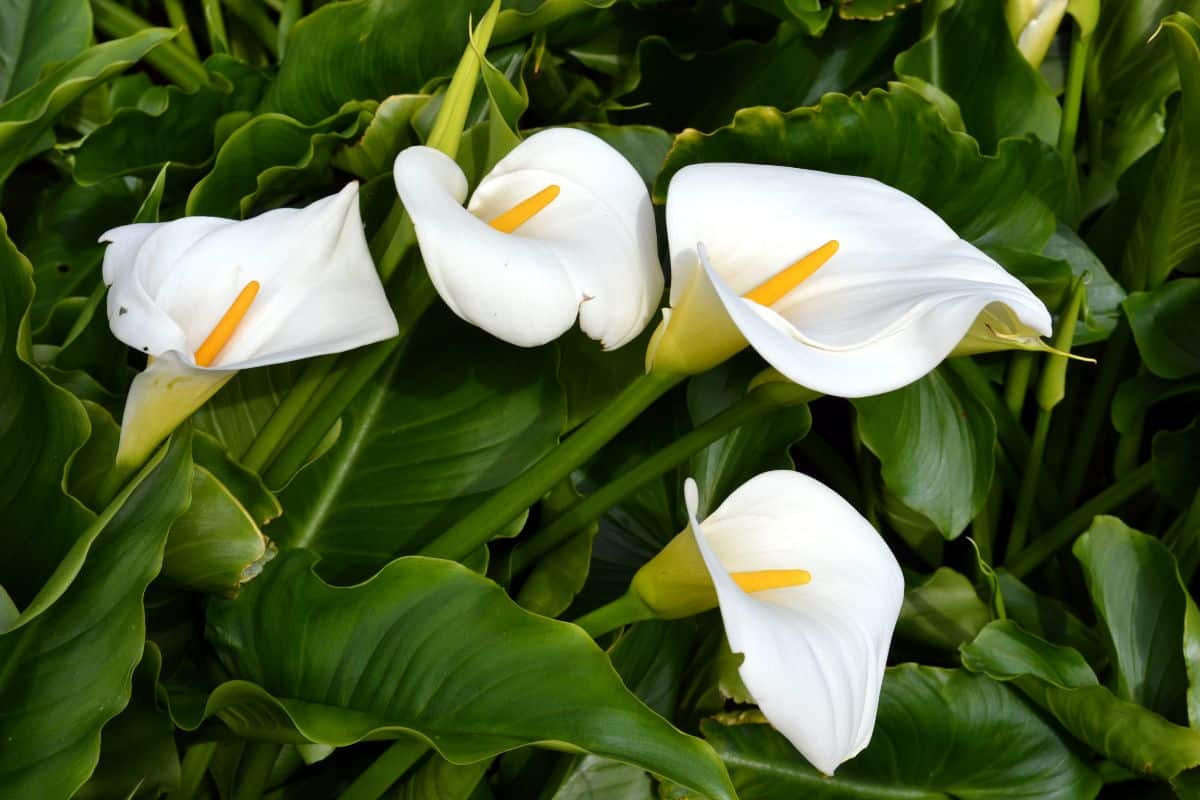
Here are some reasons to think about planting calla lilies:
• Calla lilies make fantastic cut flowers, particularly for wedding bouquets. With proper care, you can enjoy their blooms for up to two weeks. One thing to note, however, is that the pollen loves to get everywhere and stain everything. So, make sure you have brushed it off before you bring calla lilies indoors for your floral arrangements.
• As deer- and rabbit-resistant plants, calla lilies are generally left unmolested.
• Even though calla lilies may look like fussy plants, they are actually pretty easy to grow and care for. Their pruning needs are minimal, and given suitable conditions; they will reward you year after year.
• Calla lilies have a unique look of unsurpassed elegance. Their appearance is almost minimalist. Wherever you plant them, they will make a statement.
• While calla lilies will be happy in your flower beds, they are also a great choice for containers.
When Do Calla Lilies Bloom?
Calla lilies usually bloom during mid or late summer.
How Long Do Calla Lilies Bloom?
The bloom period for calla lilies is around one month.
When to Plant Calla Lilies
You should plant calla lilies in spring. Make sure that the last frost is behind you. If you don’t want to wait that long to get started, you can begin a month early indoors and then transfer the plants outdoors after the last frost.
Ideal Growing Conditions for Calla Lilies
Let’s take a look at the sun, soil, and water requirements for calla lilies to thrive at their best.
How Much Sun Do Calla Lilies Need?
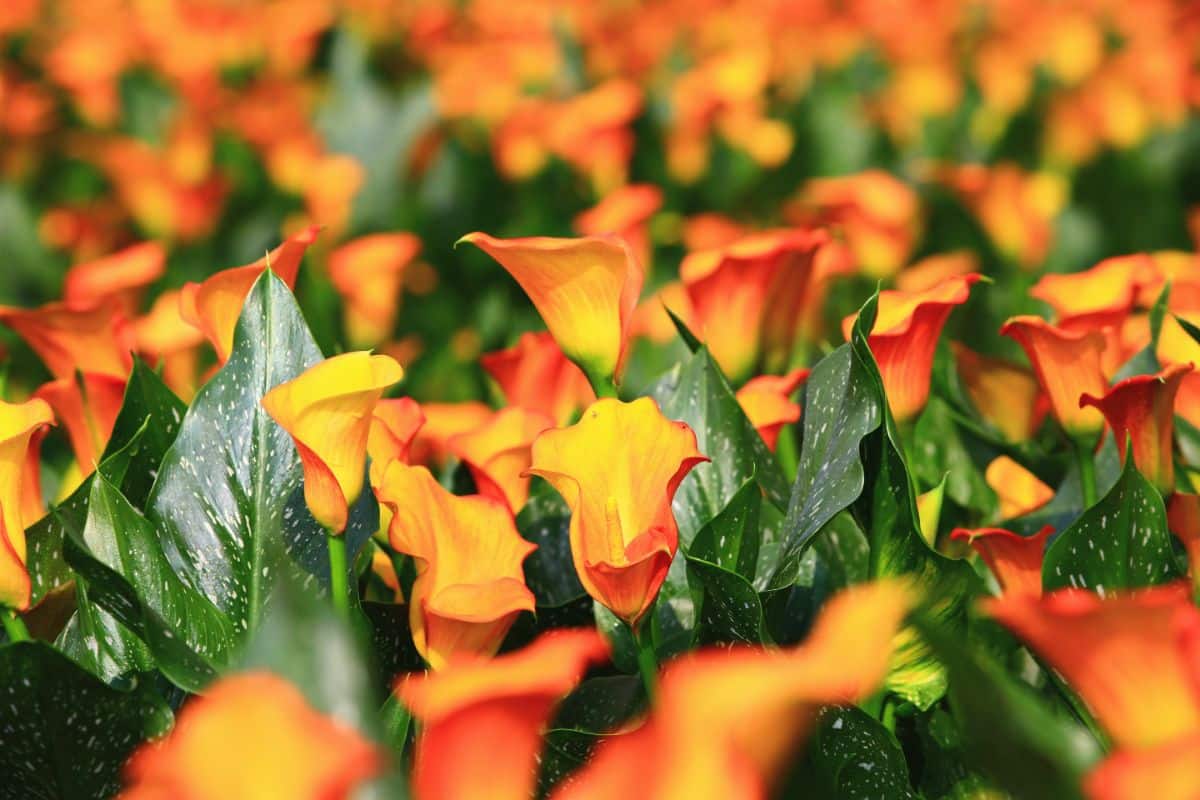
A sunny location is suitable for calla lilies, especially if you have a cool climate zone. If you have a hot climate, you might want to pick a spot in your garden where your calla lilies can get a little afternoon shade.
What Type of Soil is Right for Calla Lilies?
Moist, well-drained soil is ideal for calla lilies. That said, they are tolerant of wet soil. But while soggy soil is okay, they do not want to be in standing water. The soil must drain.
Rich, fertile soil will help your calla lilies bloom each year. To improve drainage while enriching the soil, you can mix in organic materials like compost.
Slightly acidic garden soil is suitable when it comes to pH; adding compost will make the soil more acidic, so that is another benefit of mixing it in before you plant your calla lilies.
How Much Water Do Calla Lilies Need?
Your calla lilies need regular watering during their growing seasons. An inch of water per week is generally good; precipitation may sometimes provide all the water your calla lilies need; other times, you might need to supplement the water to keep the soil moist.
How to Plant Calla Lilies
Although it is possible to grow calla lilies from seeds, it takes a long time to get them to flower. For that reason, you will generally purchase calla lily rhizomes and plant those. Let’s go over how to plant them in containers or your garden beds.
Ground Planting
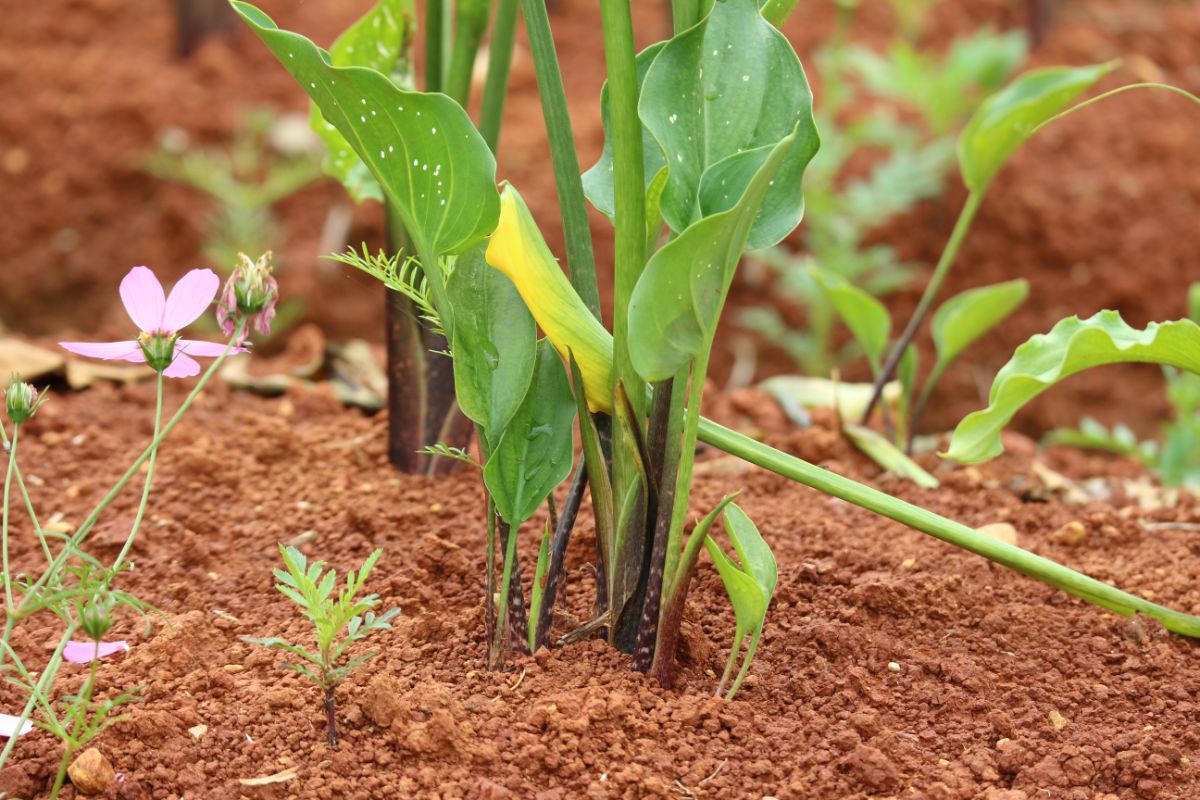
Here are the steps you can take to plant calla lilies in your flower beds.
1. Pick a location for your calla lilies, and prepare the soil. You will want to mix in some organic materials, such as manure or compost.
2. Dig holes that are about four inches deep. Each should be spaced about a foot away from each other; calla lilies require plenty of room.
3. Plant the calla lily rhizomes and backfill the soil.
4. Water well.
Often when we plant perennials, we say that you should give them extra water while they are establishing, but calla lilies are a bit different.
Dutch Grown says that after planting calla lilies, it is better to water them “sparingly” at first. You should wait until the plants develop some leaves before you increase the amount of water you are giving them.
Container Planting
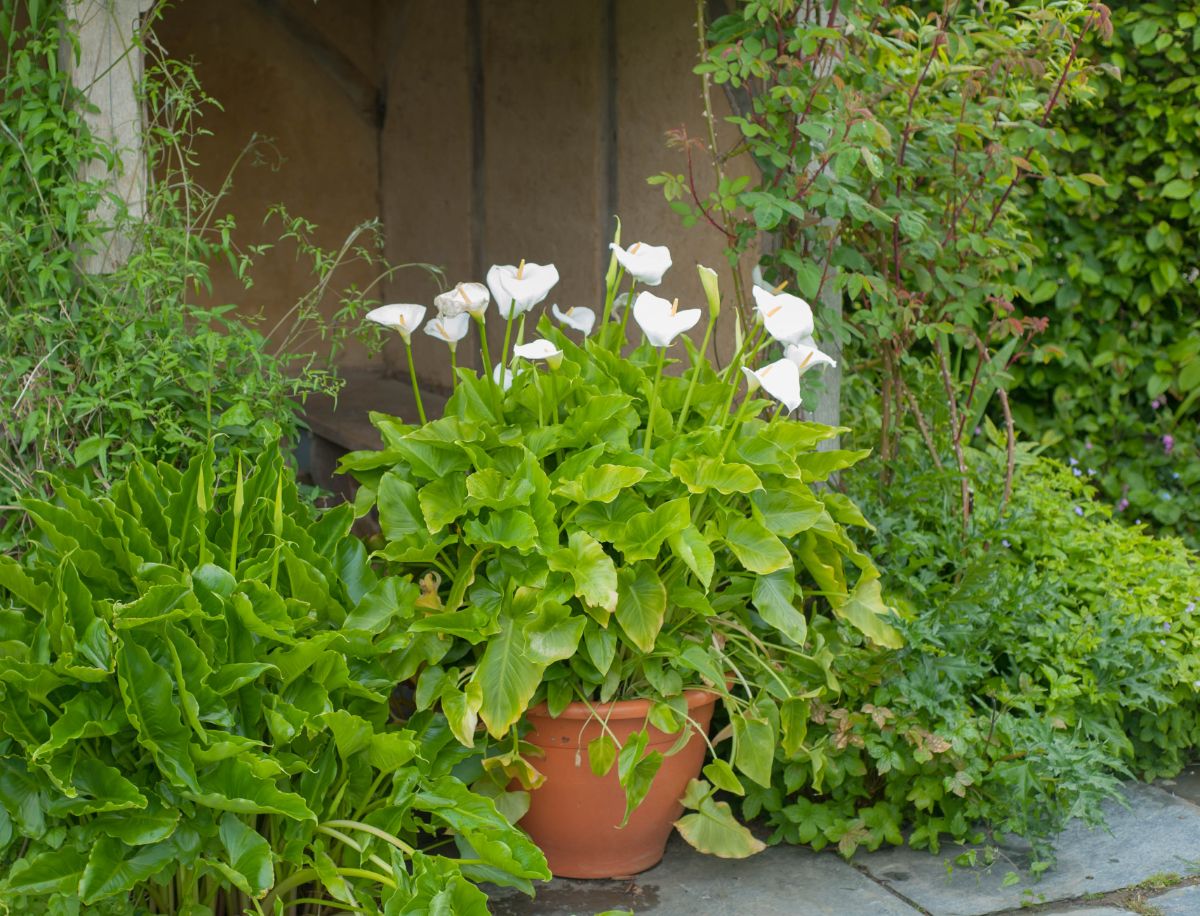
Interested in adding potted calla lilies to your landscape? Here are the steps to planting calla lilies in your container garden.
1. Calla lilies can make fantastic container plants, but only if you start with the right containers. A good minimum diameter is around 10-12 inches. The pots should also be relatively deep. Of course, they will also need holes for drainage.
2. To successfully keep calla lilies as container-grown plants, you will also need to fill them with appropriate soil-less potting mix. Mix in some sand, peat moss, and bone meal.
3. Plant the rhizome and finish filling in the potting mix around and over it.
4. Water after planting.
5. Find a location for your potted calla lilies. Consider putting trays with rocks and water underneath the containers so that your calla lilies can get extra water should they need it.
How to Propagate Calla Lilies
There are a couple of options for propagating your calla lilies. If you have a lot of patience, you can grow them from seeds. The more popular method is simply to propagate them through divisions. Below, you can learn how to do both.
Starting Calla Lilies from Seed
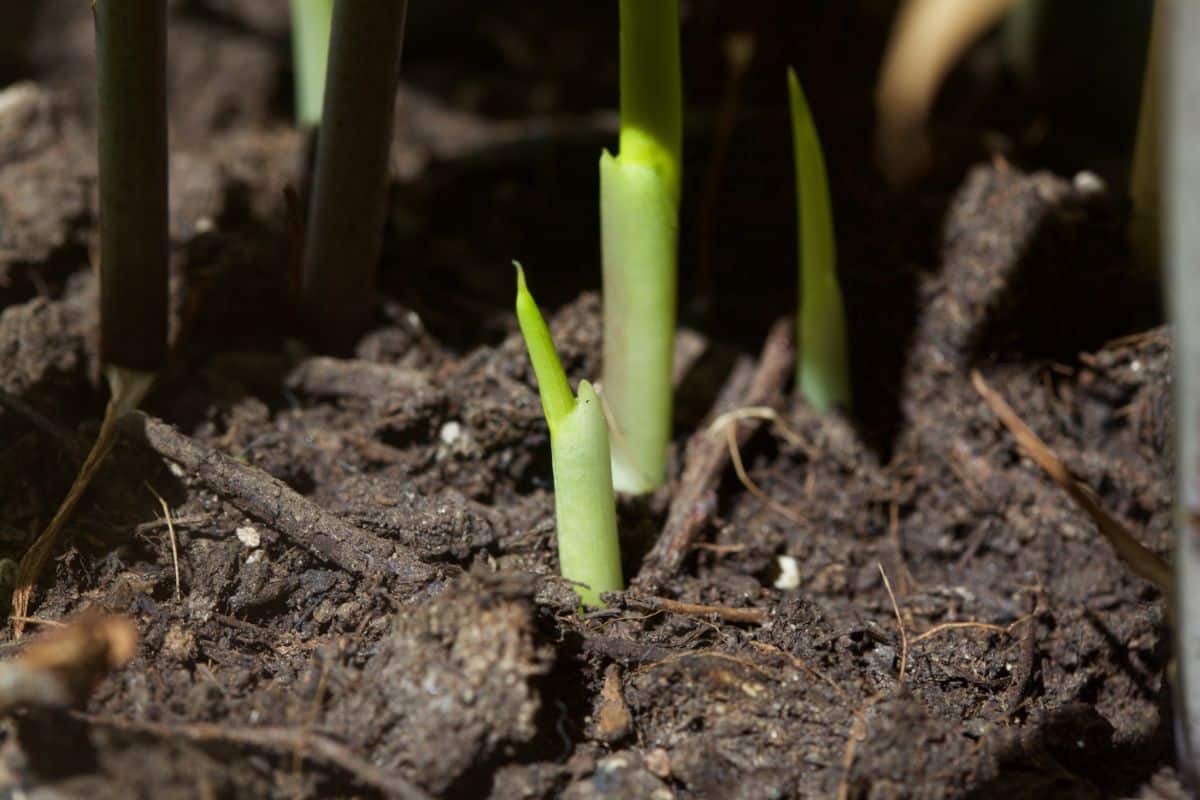
1. Collect your calla lily seeds.
2. Moisten a piece of paper towel. It should be damp but not dripping wet.
3. Place the seeds on top of the paper towel.
4. Cover the paper towel and seeds.
5. Find a cool spot for your seeds to start germinating. Wait a few days, and then look to see if any of the seeds are germinating.
6. Get a pot with drainage holes and fill it with a soilless medium.
7. Transfer the seeds that are germinating to the medium and cover them lightly. Get rid of the ones that are doing nothing, as they are not viable.
8. Use a spray bottle to get the medium moist.
9. Cover the pot and wait. Check on it periodically to moisten the soil if it is starting to dry out.
10. It is recommended that after a couple of weeks go by, you thin out the plants, keeping only the ones that are doing the best.
11. Eventually, you will have to transplant the seedlings to larger containers or move them outside. Make sure that you harden the seedlings before you place them outdoors.
Note that the calla lilies will not produce their “flowers” in the first year you grow them from seeds. It may take several years before they do, so be patient.
How to Divide Calla Lilies
Fall is the best time to divide calla lilies. Wait for the leaves to brown. Then, follow the steps below:
1. Use a shovel to dig down in a circle around the calla lily, staying away from the roots.
2. Push the shovel under the plant and pry it up out of the ground.
3. Carefully wipe away the excess soil so you can better see what you are doing.
4. Make your divisions. You can do this by hand, or you can use a knife if you need to. There need to be one or more eyes for all of your divisions.
5. Do not immediately transplant the separated divisions. The cuts are vulnerable to infection, so it is better for them to have a chance to form calluses. They can do that if you leave them out to dry.
6. After a day, you can transplant them if you are in zone 8-10, where the calla lilies can survive winter outdoors.
If you are in a colder climate zone, you will instead need to overwinter the rhizomes indoors and then transplant them when spring rolls around. For more details, see the section on How to Overwinter Calla Lilies further on in this guide.
How to Care for Calla Lilies

Now that you know how to plant calla lilies, it is time to learn how to take care of them. Let’s talk about what to know about fertilizing, mulching, and more.
How to Fertilize Calla Lilies
You can fertilize your calla lilies when you plant them. You can then do so once a year in springtime. Compost and other organic materials work well.
If you are not seeing a lot of blooms on your calla lilies, it could be because you are using a fertilizer that contains too high a ratio of nitrogen.
How to Mulch Calla Lilies
There are several reasons to mulch around your calla lilies:
• You can prevent weeds from crowding around your lilies.
• You can help keep the soil moist.
• Mulching can help to regulate the temperature of the soil, insulating against extremes.
When is the best time to mulch? Some sources say to apply mulch each spring. Others say to do it in autumn.
If you will be keeping your calla lilies outdoors year-round, it makes sense to mulch in the fall so that they have some protection from cold temperatures in winter. But if you will only be keeping them outdoors during the growing season, then it makes more sense to just do it in spring.
How to Stake Calla Lilies
You may have noticed that as calla lilies get taller, they also get heavier. They may sometimes flop over or even break.
The best way to deal with this problem is to drive stakes into the ground before you plant your calla lilies. Then, you can tie the stems to the stakes as they grow for extra support.
Why should you put the stakes in the ground before planting the lilies? Because if you reverse these steps, you could accidentally damage the rhizomes when driving the stakes into the soil.
What if you are dealing with broken calla lily stems anyway (perhaps because you didn’t put stakes in when you planted them originally)? If that is the case in your garden right now, you can always bring the broken calla lilies indoors as cut flowers to enjoy.
How to Prune Calla Lilies
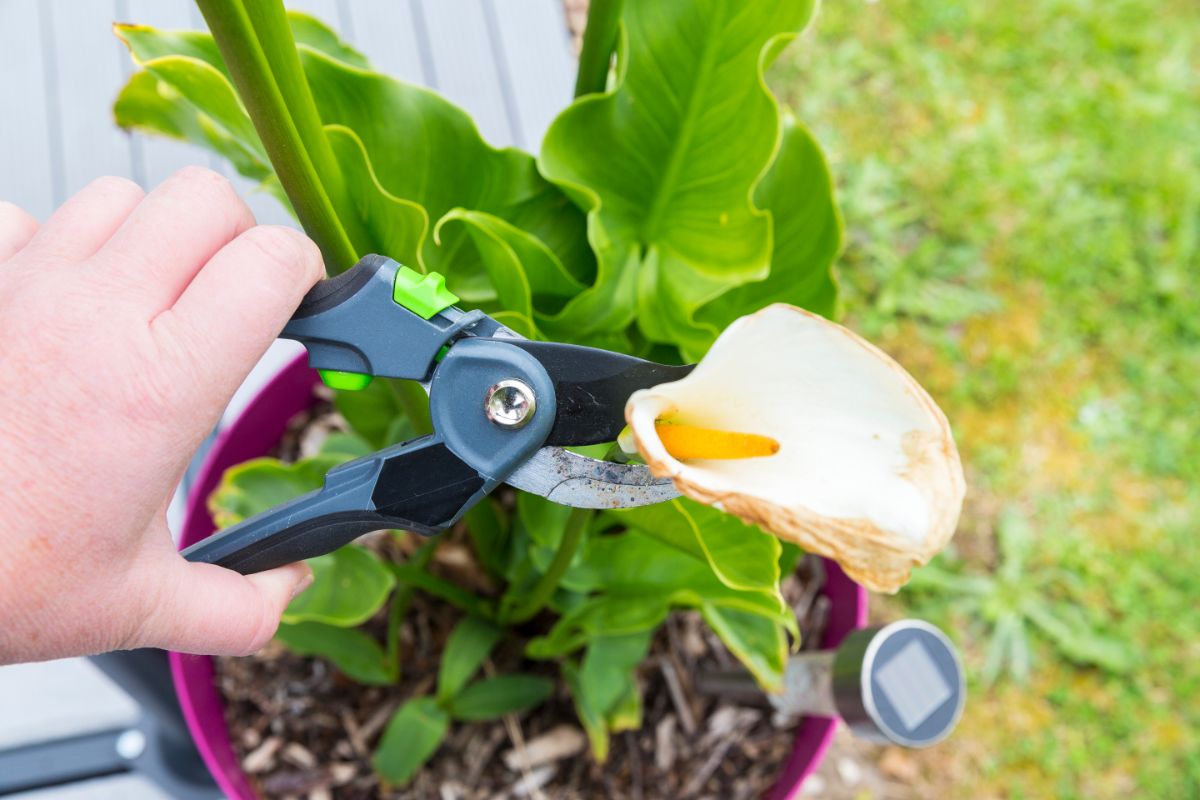
Pruning your calla lilies is quite easy; you just need to deadhead them and trim them back. Learn more about both below.
How to Deadhead Calla Lilies
You cannot get a calla lily to bloom again by deadheading it. Nonetheless, you still are going to want to deadhead your calla lilies.
Every year, your calla lily will go dormant for the winter, and then produce a new bloom the following year. When you deadhead the spent bloom, you give the plant a chance to start putting energy into the rhizome instead of wasting it on wilting parts. That way, it is more likely to produce a spectacular bloom the next year.
Wilted calla lilies also do not have a tidy appearance. So, if you want to keep your garden looking neat, it makes sense to deadhead them.
When to Cut Back Calla Lilies
Late in the season, frost will turn the foliage of your calla lilies yellow. When that happens, they are done for the season, and it is time to trim them back. Leave a couple of inches of stem intact.
You are now ready to overwinter the calla lilies (see below).
How to Overwinter Calla Lilies
If you live in a cool climate zone and want to grow calla lilies as perennials, you will need to overwinter them indoors. Iowa State University Extension and Outreach offers the following instructions:
“Calla lilies (Zantedeschia spp.) are tender perennials. Their rhizomes must be dug up in the fall and stored indoors over the winter months. After a killing frost, cut off the foliage 1 to 2 inches above the soil surface. Carefully dig up the rhizomes. Do not cut or injure the rhizomes. Dry the rhizomes in a warm, dry location for 1 to 2 weeks. After drying, bury the rhizomes in vermiculite, sawdust, or peat moss. Store the rhizomes in a cool (50 to 60 degrees Fahrenheit), dry location.“
Growing Calla Lilies as Houseplants
You can grow calla lilies as houseplants indoors year-round if you’d like. Find a spot close to a sunny window where the lilies will receive indirect light, and water them often enough to maintain the moisture of the potting mix. Try and keep temperatures moderate; you do not want the plants to get extremely hot or extremely cold. So, right next to a radiator or in the direct path of an air conditioner is not ideal.
Even when you are keeping calla lilies indoors, you need to be aware that they will still go dormant in winter. That means that you should not keep the calla lilies by the window all year round. During winter, when they are dormant, you need to move them someplace cool and dark. Then, when spring comes, you can put them back near the window for their next growing season.
Are Calla Lilies Vulnerable to Diseases or Pests?
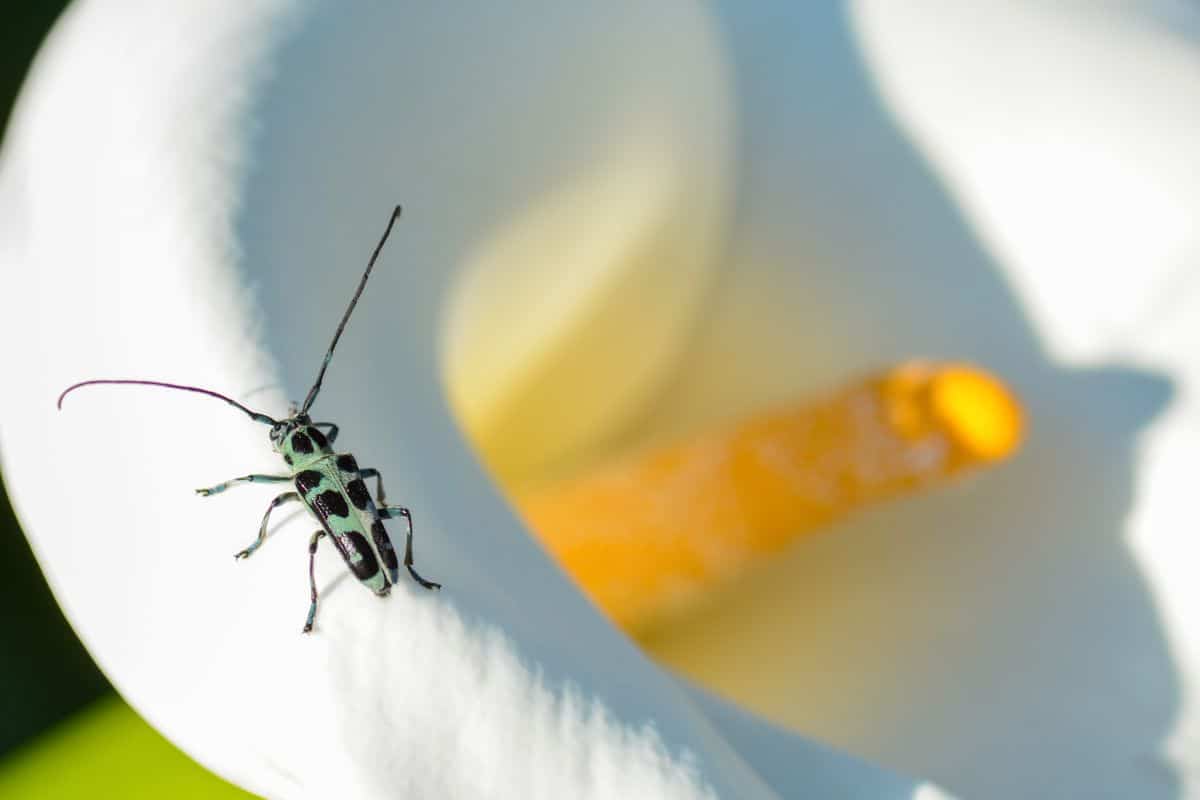
Some of the diseases that can affect calla lilies include powdery mildew, bacterial soft rot, root rot, botrytis, viruses, crown rot, and pythium rot.
Despite calla lilies’ relative tolerance for moist conditions, these plants still need well-draining soil and adequate air circulation. Make sure they are getting both, and you are less likely to run into rot problems.
Some of the pests that can cause problems for calla lilies include aphids, spider mites, whiteflies, thrips, slugs, and snails.
Calla lilies are an excellent choice if you are looking for a plant that is deer-resistant and also rabbit-resistant.
Recommended Planting Combinations for Calla Lily
Here are a few plants that can make suitable companions for your calla lilies:
• Geraniums: Like your calla lilies, geraniums appreciate moist, well-draining soil. See our Geraniums Full Growing Guide.
• Canna Lilies: If you are going to grow your calla lilies in full sun, a good companion for them are the similarly-named canna lilies. They will do well in the same soil conditions and also bloom during summer.
• Gladiolus: These plants, also called “sword lilies,” may be happy next to your calla lilies. But make sure you do not plant them in soil that is too damp. See our Gladiolus Full Growing Guide.
Calla Lily Landscaping Ideas
Here are a few ideas for how to use calla lilies in your landscaping.
• Slopes: Calla lilies can grow on slopes more successfully than a lot of other plants. Consider massing them in a hilly part of your garden.
• Border: Calla lilies are popular as border plants, either mixed with other perennials or on their own.
• Focal point: A cluster of calla lilies can draw the eye with ease, making them ideal for creating elegant focal points in your landscaping.
• Container plants: Potted calla lilies can add a touch of sophistication to your patio or deck.
• Near water features: Since calla lilies can thrive in soggier soil than many other plants, they are great for planting next to ponds or other water features in your backyard.
Recommended Calla Lily Varieties
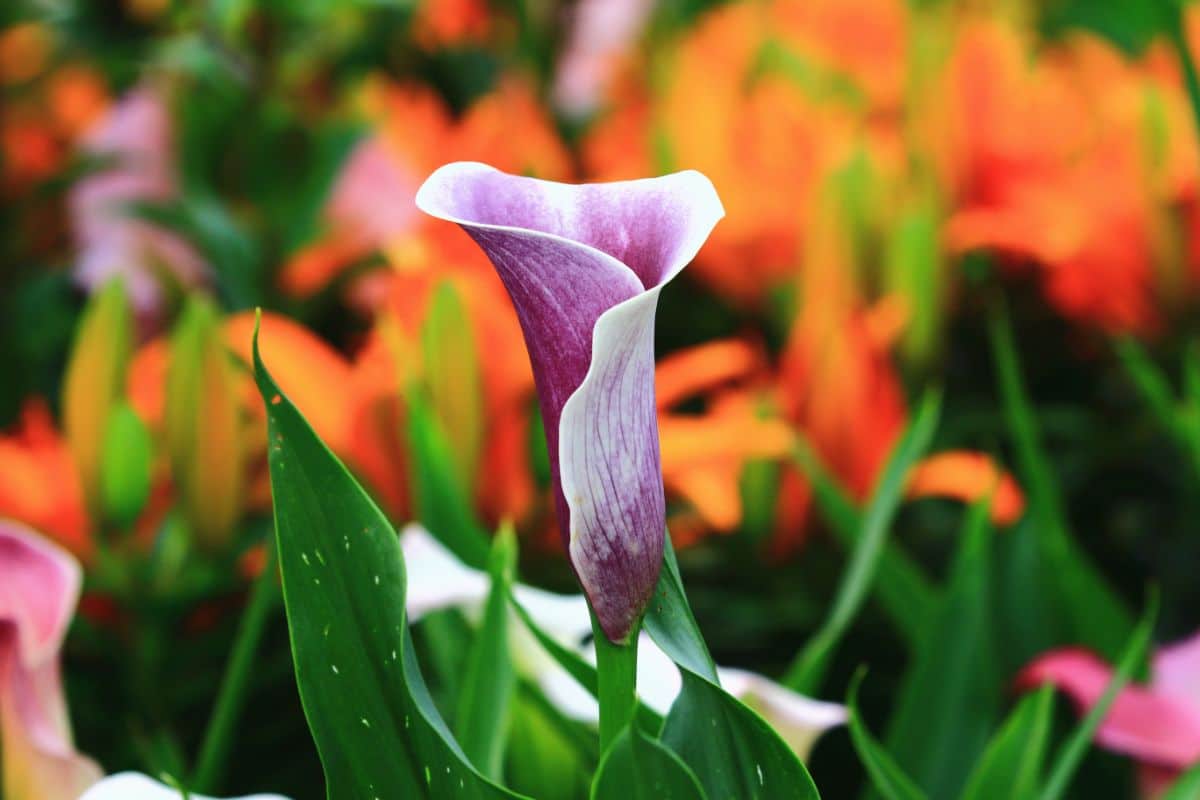
Now that you know how to grow calla lilies, let’s take a look at some of the varieties and cultivars that can bring a touch of elegance to your garden:
• Acapulco Gold: For sunny yellow calla lilies, consider these vibrant plants. They are fairly compact, which makes them a versatile choice in your garden.
• Rubylite Pink Ice Calla Lily: This calla lily is named for the unique coloration of the flowers, which are a blend of white and pink.
• Classic Harmony: If you want a type of calla lily that has a beautiful muted elegance, think about getting this cultivar. The blooms are a subtle brownish-peachy color.
• Apricot Lady: Speaking of peachy hues, the gorgeous blooms on this cultivar are a warm peachy orange color that is slightly darker around the edges.
• Pink Melody: For more beautiful blooms in shades of pink, think about getting this cultivar, which features hues of white and bright pink.
• Crowborough: One type of white calla lily that will impress you is this cultivar with its large blooms.
• Green Goddess: For an unusual look, try this cultivar. The blooms are white, with dark leafy green at the tips.
• Odessa: Did you know you can get a black calla lily in the form of the “Odessa’ cultivar? The blooms are actually a really deep purplish color, but in the right lighting, you won’t be able to tell the difference. Plant them alongside white calla lilies for a really striking contrast.
• Picasso: The deep pink throats fade to white on the breathtaking spathes of the “Picasso” cultivar.
• Red Alert: As you might guess from the name, the floral display put on by these calla lilies is bright red.
• Majestic Red: The spathes of this type of calla lily are somewhere between a true red and a deep burgundy.
• Hot Mix: This is a blend that combines the fiery shades of multiple cultivars: Sunshine, Allure and Red Alert. The variety of colors will really heat things up in your garden.
• Night Cap: For an elegant display in a deep reddish-purplish hue, consider planting this lovely cultivar. It is an excellent choice for planting alongside a water feature since it prefers the soil to be on the soggier side.
• Captain Reno Calla: This exceptional calla lily is prized as much for its speckled foliage as it is for its reddish blooms.
• Captain Violetta: For a display of flowers with an attractive muted purplish color, think about planting this cultivar.
• Black Star: Another option for black calla lilies in your garden is this cultivar. Similar to Reno, it also comes with speckled leaves.
• Flame: With a name like “Flame,” you can easily guess what these blooms will look like. They feature shades of red, orange, and yellow on the flowers with speckling on the leaves.
• Bridal Bouquet: This is a mix that includes the cultivars “Purple Sensation,” “Picasso” and “Lavender Sensation.”
• Morning Sun: The peachy, pinkish, and yellowish hues of these blooms will remind you of the rising sun.
• Anneke: Another lovely choice for a cultivar that produces purple flowers is this one. You’ll find that the blooms are just the right hue to make a perfect contrast with the speckled green leaves.
• Black Magic: Defying expectations, the blooms of this calla lily are not actually black. They are bright yellow. But the throats are black, thus the name of the cultivar. The leaves feature speckles.
• Millennium Gold: The name of this cultivar refers to the golden yellow hue of its blooms. The speckling on the foliage is more prominent than it is on most other cultivars of calla lilies.
• Purple Sensation: For calla lilies that really stand out with their bold hue, get this cultivar. The purple color of the blooms gets deeper and darker in the throats.
• Siberia: Another stunning option for white blooms is this cultivar with its speckled foliage.
Frequently Asked Questions About Growing Calla Lilies
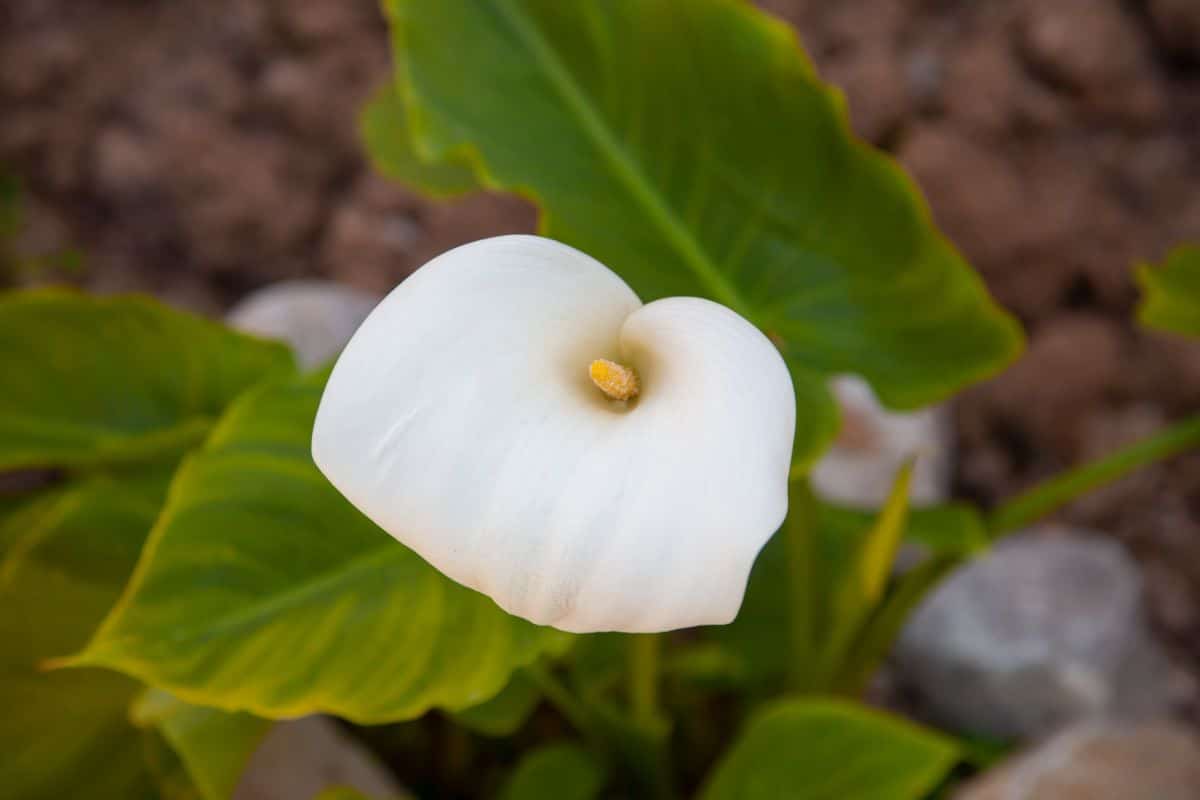
Let’s wrap up our calla lily growing guide with answers to a few frequently asked questions.
Due to the oxalate crystals in calla lilies (see below), mammals like deer and rabbits tend to avoid eating them. If something has been eating your lilies, insects, slugs, or snails are more likely culprits.
No, calla lilies are definitely not edible. As explained here, there are “needle-like” crystals in calla lilies called oxalate crystals. As you would gather, given that description, they are painful to ingest, and they are in every part of the plant.
If you were to eat calla lily, you would likely experience symptoms such as burning pain, painful swallowing, drooling, nausea, a hoarse voice, swelling, trouble breathing (sometimes deadly), and vomiting.
Poison Control states that one should not induce vomiting if a calla lily is eaten. In most cases, the effects will not be lethal. That said, if you notice severe swelling and difficulty breathing, you will need to get medical attention right away.
Not surprisingly, cats and dogs also should not eat calla lilies. The same oxalate crystals will cause irritation. Symptoms might include foaming or drooling and possibly vomiting.
As with humans, it is unlikely that your pet will die after eating calla lily, but it is not impossible. If there is swelling and trouble breathing, take your pet immediately to the vet.
You will discover that calla lilies can be pricey, whether you are buying live plants for your garden or cutting flowers for a bouquet.
The good news is that you can propagate calla lilies. That means that if you invest in just a few calla lilies this year, over the years ahead, you will end up with more. So, over the long run, they are not as expensive as you think.
Growing calla lilies in your garden is also a good way to get calla lilies for arrangements every year without having to spend a lot of money on cut flowers.
Calla lilies can spread, yes. In some locations, they are considered to be invasive. So, check which species are considered invasive in your area before you plant, and take any necessary precautions for containment.
Yes, during the winter months, calla lilies go dormant. That is why it is possible to dig up the rhizomes and overwinter them indoors.
Where to Buy Calla Lilies
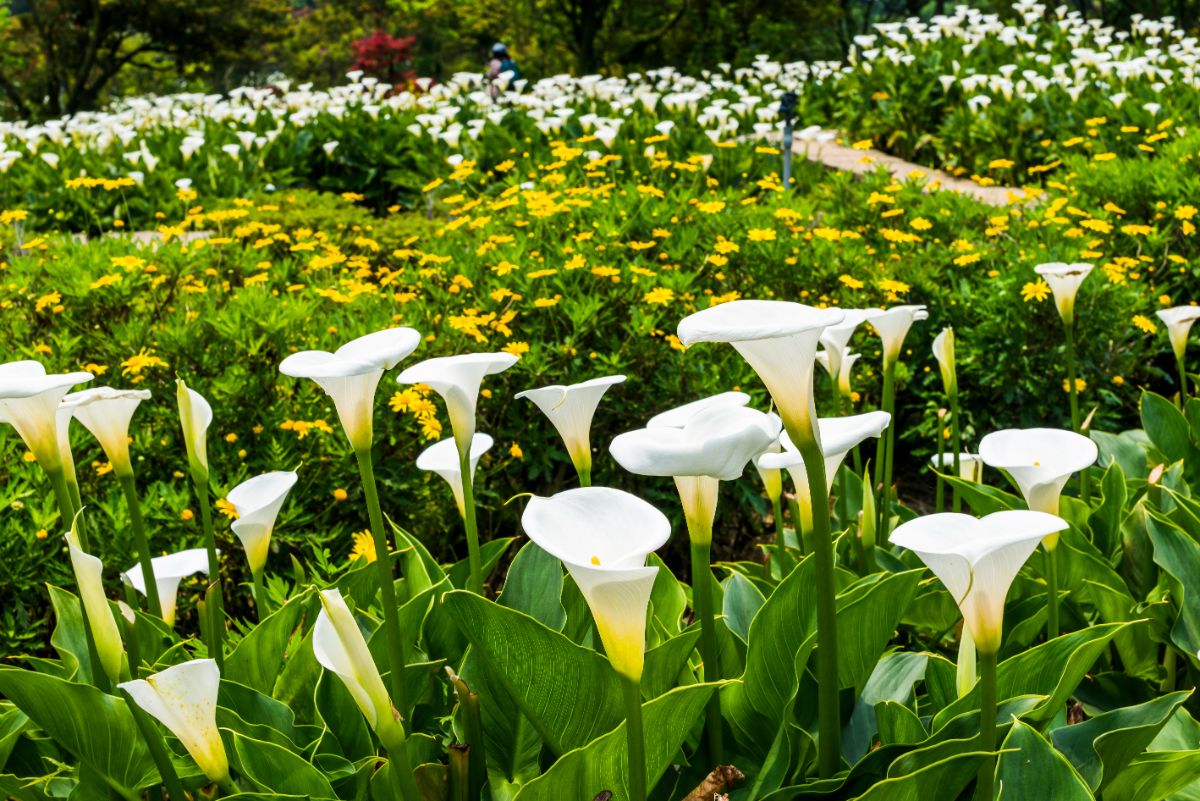
Having read through our full calla lily grow guide, you are now ready to start growing some of these elegant tender perennials in your own garden. To access the largest selection of calla lily cultivars, shop for calla lilies online.






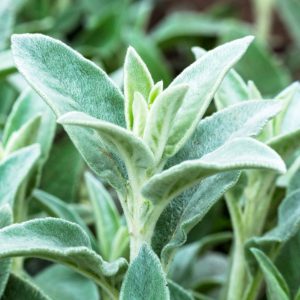


Lila
My calla lollies grow beautifully every spring and summer. Ive followed the directions carefully. In the 5 years I've had them, I've only ever had one bloom. What should I try?